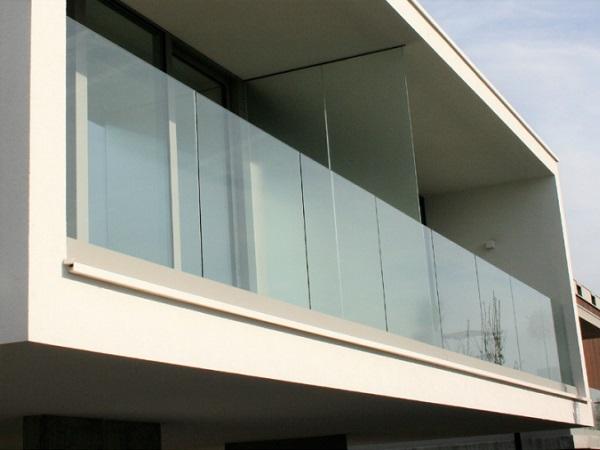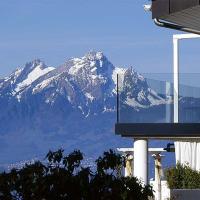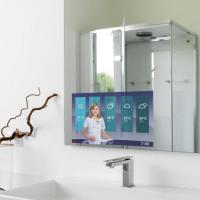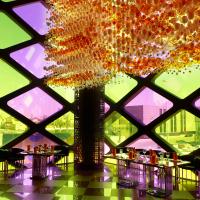This paper was first presented at GPD 2019 by Ir. Hugues Lefevre and Ing. Anna Šikyňová from AGC Glass Europe, Belgium.
Laminated glass incorporating stiff PVB is being used increasingly in structural applications. This combination improves the load resistance of the laminated glass sheet, reduces deflection, helps to reduce the thickness and weight of the glass and, in some cases, renders it unnecessary to thermally treat the glass. The case of freestanding balustrades is studied in depth, with the thermally toughened laminated glass usually used replaced by annealed laminated glass.
Experimental testing under static and dynamic impact loads is discussed with respect to load, glass thickness and type of linear fixation. The findings of experimental research are also evaluated in the light of national legislation. Aspects of post-breakage behaviour are investigated. Finally, it is shown that the use of a stiff PVB interlayer combined with annealed glass is acceptable and safe for balustrade applications.
Authors
Hugues Lefèvre is a laminated glass product manager at AGC Glass Europe. He has more than 25 years of experience in the glass industry in a wide range of fields, including research and development, sales and marketing of glass products. He is a member of several technical glass committees and international associations. Hugues Lefevre holds a Degree in Mechanical Engineering from the Catholic University of Louvain, an MBA from the EPM school and a Certificate in Legal Expertise from the Catholic University of Louvain (Belgium).
Anna Šikyňová joined the fascinating world of glass ten years ago. She was appointed head of the Technical Advisory Service at AGC Glass Europe in 2015. Her work routinely involves combining structural, thermal, safety, security, acoustical and other design considerations for international projects. She holds a Degree in Civil Engineering from the Slovak University of Technology, Faculty of Civil Engineering, Bratislava (Slovakia).
1. Introduction
The demand for structural glass balustrades fixed on one side only is growing significantly due to the high demand for contemporary design-oriented frameless constructions capable of delivering unobstructed views (see picture 1).
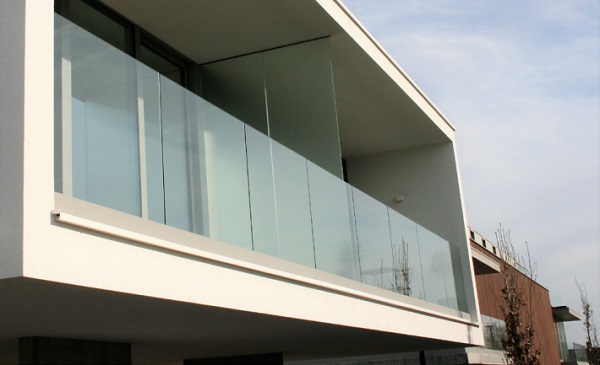
The first generation of such balustrades appeared in the late nineties and used metal fixing points to fix the glass and metal profile through holes in the glass.
The second generation, which appeared around 2010, consists of uniformly supported systems comprising continuous aluminium profiles fixed to the ground and clamped to glass panels. Several firms developed innovative linear aluminium profiles to replace point fixing. This new generation of structural glass balustrades led to lower costs, easier and faster installation via standardised modules, and improved aesthetics (see picture 2).
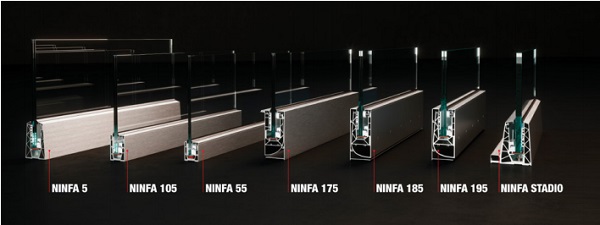
Typically, laminated glass thermally toughened or heat-strengthened was used in structural balustrades, but is thermally treated glass really useful or necessary in secondgeneration structural balustrades since stress concentrations have been eliminated?
Thermally toughened or heat-strengthened laminated glass has multiple disadvantages: complicated to produce and expensive; long delivery times since it is not a stock product; imperfect aesthetics with optical distortions; potentially subject to NiS breakage; poor aesthetic of edge finishing and dubious breakage behaviour
Recently, certain interlayer producers have introduced structural polyvinyl butyral (PVB) interlayers that are markedly stiffer than conventional interlayers [1].
This paper presents an evaluation of the use of annealed laminated glass incorporating these stiffer PVB interlayers as a solution for replacing thermally toughened or heatstrengthened laminated glass in uniformly supported systems using continuous aluminium profiles.
Structural glass balustrades are subject to a complex and changing regulatory framework in Europe. The general principles and applicable loads can be derived from the structural Eurocodes [6], but a specific Eurocode for glass is not available and is still under development. In the particular case of structural balustrades and in the absence of European standards on glass dimensioning, the design of such structures is still regulated by countries’ national standards, which are all different and which specify special requirements, such as static and/or dynamic testing of complete systems (glass and fixation) as well as digital simulations.
In the first part of this paper, we present the requirements set out in these national standards for a group of European countries. In the second part, we investigate and check by physical testing if balustrades in annealed glass with stiff PVB can qualify according to national standards in Belgium (NBN B 03-004 [3]), Italy (UNI 11678 [14]), Spain (UNE 85-238- 91 [13]) and Slovakia (STN 74 3305:2016 [17]).
All physical testing was conducted by certified laboratories in each country using different aluminium rail systems for fixation and AGC Stratobel Strong [18] as the annealed laminated glass incorporating stiff structural PVB.
2. Design rules, legislation and standard by country
Glass balustrades are designed according to different national standards. They are simulated using finite element analysis or they are tested in laboratories.
2.1 An overview of imposed static loads generated by users applied to balustrades
Some countries have specific loading and design rules for glass balustrades. In countries without specific rules, table 6.12 in Eurocode 1 is used to identify design loads. The tables 1, 2 and 3 show loads on balustrades in different countries and per categories of use (cat. A Residential, cat. B Offices, cat. C Areas where people may congregate, cat. D shopping areas).
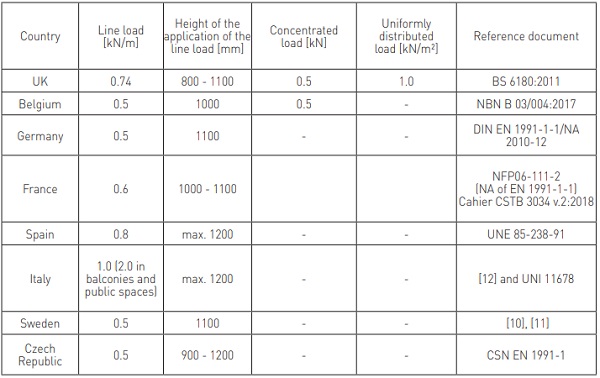
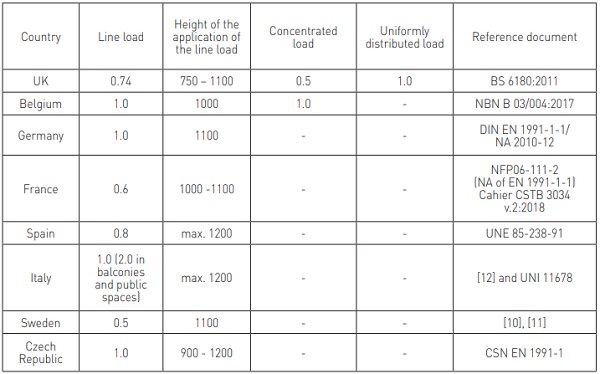
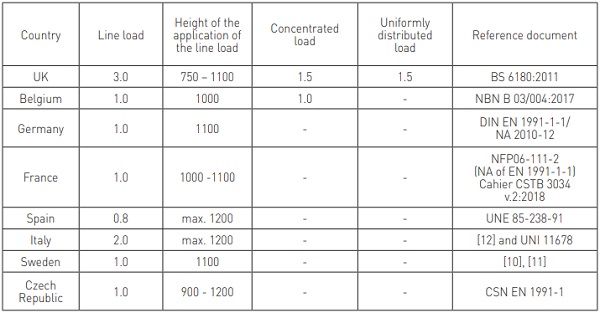
2.2 Wind load
All buildings are exposed to wind, but wind load is sometimes forgotten in the validation process for balustrades. Moreover, balustrades behave as free-standing walls and are exposed to stronger winds than facades. In taller buildings, the wind load may exceed the load applied by users.
Some balustrade systems and their fixation to the main structure are designed to resist loads only in one direction. The fact that wind may act in both directions is often forgotten. Belgium and France have a defined procedure to include wind load in testing process.
2.3 Dynamic impacts on balustrades
Balustrades as protective barriers should protect individuals from various hazards or should restrict their movements. Different impact tests have been designed to prevent certain accidental situations. The soft impact test, represented by a cylinder with two pneumatic tyres or by a bag, both weighting 50 kg, simulates the impact of a person.
The impact of a steel ball simulates the accidental throwing of a tool (hard impact). Dynamic impacts are tested on the original setup (glass configuration, dimensions, supporting system and anchoring to the main structure). German and Czech standards allow simulation of a soft impact using finite element analysis. The tables 4 and 5 describe impact tests in selected countries.
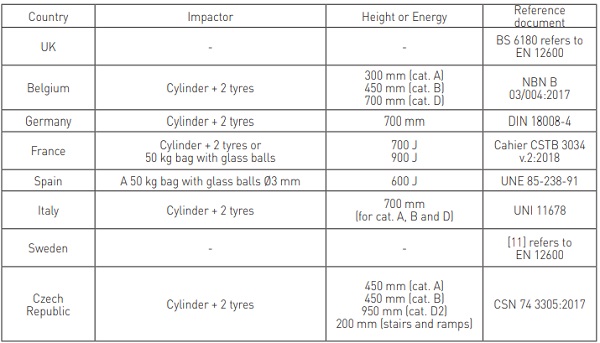
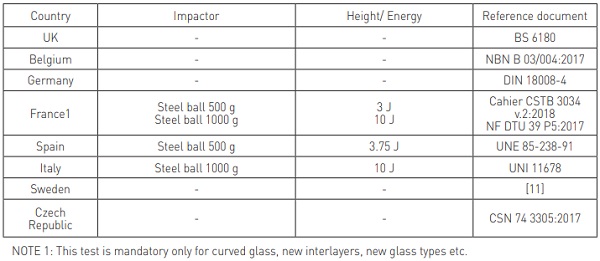
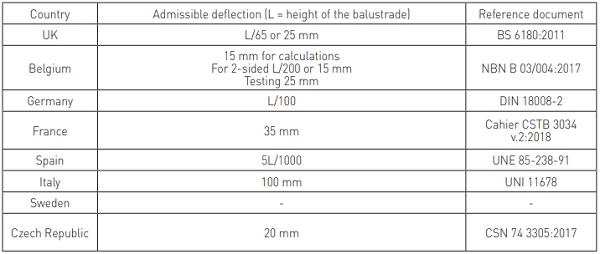
2.4 Serviceability criteria
Admissible deflection depends on national standards. Some countries allow high deflection (Italy), while others maintain very strict serviceability criteria (Belgium).
2.5 Temperature during testing
The temperature during test is not always mentioned in the national codes. If mentioned, the temperature is in the range 15°C to 25°C.
In France, the findings of the tests cannot be used when a higher surface temperature is expected (e.g. balustrades exposed to solar radiation).
In the EU, only one standard requires glass balustrades to be tested at specific temperature : Slovak standard STN 74 3305:2016. Balustrades made with brittle materials must resist an impact by cylinder and two tyres at -15°C. Depending on the category of use, the tyres will be dropped from a height 1000 or 1400 mm.
2.6 Post-breakage behaviour
Glass is a brittle material. Its behaviour during and after accidental breakage is difficult to predict and may vary depending on the application, dimensions, supporting system, composition, type of glass, type of interlayer, environmental conditions, etc. When designing protective barriers, post-breakage behaviour must be analysed. Only Belgium, Italy and Germany mention testing procedure for post breakage situation.
2.7 Protection of edges
In Germany, the unprotected upper edge of free standing balustrades is not allowed. In the UK, the handrail is mandatory for all balustrades except of those in which toughened laminated glass - which remains stable after failure - is used. In Sweden and in Czech Republic, the handrail is mandatory for balustrades in staircases and ramps. Unprotected edges are allowed in Belgium, Italy, Spain and France.
2.8 Other specificities of balustrade design in Europe
As can be seen, the requirements for verifying balustrades vary from country to country. In fact, for some characteristics, national standards might even contradict each other.
In France and Italy balustrade must be tested. Numerical simulation are not allowed.
According to French standard DTU 39 P5, the use of balustrades clamped at the bottom requires official technical approval. Testing in France is always conducted without a handrail and for the minimum width of the glass. It is known that wider free-standing balustrades resist soft impact better than narrow balustrades.
3. Static and dynamic physical test and result, discussion
We had many tests conducted in approved certified laboratories in each country.
The findings presented in this paper are the results of tests complying with the protocol described in detail in each country’s national standard, as presented above. The details of each result are available in an official certified laboratory report. This means that if the report is positive, the complete system – rail fixation system and annealed laminated glass with stiff PVB – can be used in the country for real projects.
We tested 15 types of aluminium fixation rails provided by largest suppliers: Onlevel 60 (side and top); Aluminco Crystal line, A20 and L line; Massimo Logli Defender 450; Faraone Ninfa 4 and Ninfa 5; Comeza SV top and side; Q-railing Easy Eco top.
The rail and glass are installed and fixed in the laboratory in compliance with the standard supplier installation manual.
In all cases, laminated annealed Stratobel Strong was used, cut from jumbo panels and edge ground/polished. We tested multiple glass thicknesses: 88.2, 1010.2 and 1212.2. In all cases, we test 100 cm wide balustrade with height between 100 and 120 cm function of local regulation.
3.1 Physical testing per Belgian standard NBN B 03-004:2017
These tests were conducted in the following laboratory: WTC-CSTC Centre Scientifique et Technique de la Construction, 1342 Limelette, Belgium.
As defined by the Belgian standard, the wind load was taken into account as per NBN EN 1991-1-4 ANB.
Several findings are positive with annealed laminated glass and stiff PVB, meaning that these complete systems can be used in Belgium in the tested configuration. These findings are in line with known results [1]. It is clear that the same test conducted with a different type of rail will not yield the same result due to different torsion, rigidity and rail dimension. This means that each fixation system must be tested and approved with respect to national legislation.
For Belgian legislation, we can see that the maximum deflection criterion is the most restrictive. For this point, the use of stiff PVB is crucial for reducing deformation under line load [1].
3.2 Physical testing per Italian standard UNI 11678
These tests were conducted in a laboratory operated by rail suppliers. We had the findings confirmed via a final test conducted in an official certified laboratory: Politecnico di Milano, Laboratorio Prove Materiali, 20133 Milan, Italy.
Several findings are positive with annealed laminated glass and stiff PVB, meaning that these complete systems can be used in Italy in the tested configuration. It is clear that the same test conducted with a different type of rail will not yield the same result, especially for deformation, due to its own fixation rigidity.
Fixation 11 complied with the static load, but failed with a dynamic soft impact of 50 kg.
In addition, we tested the same rail but with 4-block and 6-block polymer fixation per meter. The results were better and positive with the 6-block configuration. The number of fixation block clamps also had an effect on performance and results due to better uniform stress distribution along the glass fixation. This result suggests that a real full linear blocking systems should be tested, but this has not yet been done.
One supplier also modified its rail system and designed a special rail for annealed laminated glass. This approach yielded excellent results (see table 8, fixation 12).
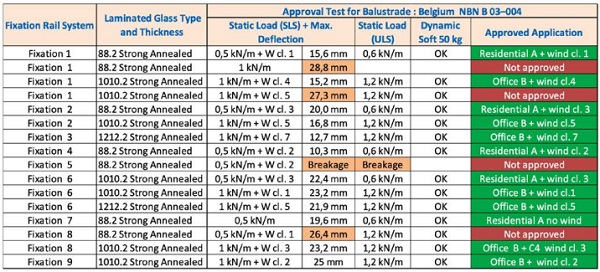



3.3 Physical testing per Spanish standard UNE 85-238-91
These tests were conducted in a laboratory operated by rail suppliers. We had the findings confirmed via a final test conducted in an official certified laboratory: Applus+ Laboratories, 08193 Barcelona, Spain.
In this particular case, a hard impact must also be considered in addition to a soft impact, as required by Spanish standards.
Several findings are positive with annealed laminated glass and stiff PVB, meaning that these complete systems can be used in Spain in the tested configuration. These findings fully confirm the results obtained with Belgian and Italian standards.
Fixation 13 is not rigid enough and cannot support the ULS static load. After every test it has to be readjusted because it is not stable. This confirms that each fixation system must be tested and approved with respect to relevant national legislation.
All tested system with annealed glass and stiff PVB passed the hard impact test.
It is interesting to note breakage behaviour with annealed laminated glass with stiff PVB (see picture 3 & 4). Breakage appeared near the rail in a multitude of aligned mediumsized fragments. This is completely different from thermal treated glass breakage and also different from monolithic annealed glass breakage. This type of breakage is safe, since the glass remains in a vertical position and continues to prevent individuals from falling. Similar breakage behaviour was observed for dynamic and static load.
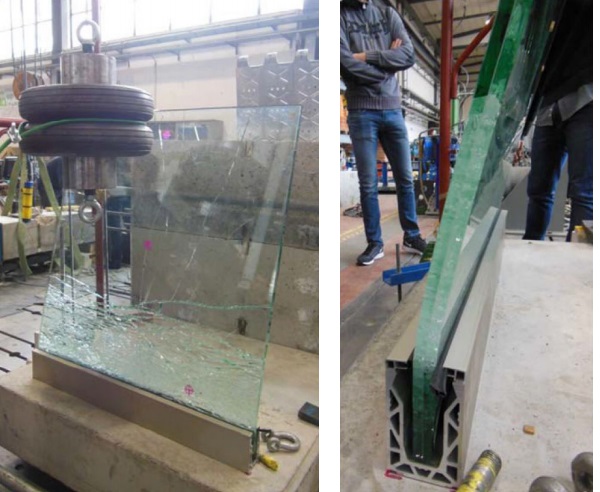
3.4 Physical testing per Slovak standard STN 74 3305:2016.
All previous findings were obtained at standard temperature in the range 20°C ±5°C as defined in national standards.
We conducted the test per Slovak standard STN 74 3305:2016, as it is the only country to prescribe testing at a different temperature, i.e. -15°C.
The tests were conducted in an official certified laboratory: Technicy a Skusobny Ustav Stavebny, Skusobne laboratorium, 82104 Bratislava, Slovakia.
The tested system comprising annealed glass 1010.2 with stiff PVB passed the soft impact test (most critical) at low temperature.
4. Conclusions
Due to the absence of European standards on glass dimensioning, structural glass balustrade are subject to complex regulations by countries’ national standards, which are all different and which specify special requirement for static and/or dynamic testing of complete systems.
We presented these varying requirements under different national standards and showed how they can be completely different and sometimes even contradictory. For example they can be more stringent in some countries, such as Italy with respect to static load, or in Belgium with respect to maximum deflection.
Using several different national standards for physical testing, we showed that using the combination of a stiff PVB interlayer with annealed glass can be acceptable and safe for balustrade applications using a continuous aluminium profile fixation system. Annealed laminated glass can be a solution for replacing thermally toughened or heat-strengthened laminated glass in modern linear fixation systems.
Post-breakage behaviour with annealed laminated glass and a stiff PVB interlayer is safe, since the glass remains in a vertical position and continues to prevent individuals from falling.
Unfortunately, not all tested rail systems yielded positive results and requirements vary from country to country. Accordingly, the use of annealed laminated glass with stiff PVB is acceptable only after testing the complete system (glass + fixation) with respect to national standards.
Finally, we recommend always using tested and approved systems with respect to the relevant load, glass thickness and type of linear fixation. Digital simulation can be used to predetermine and evaluate potential designs, but physical testing is always needed to validate aspects not covered by digital simulation, mainly anchoring to the main structure and rigidity of the profile.
The use of annealed laminated glass with stiff PVB offers many advantages: less complex and costly to produce, short delivery times since stock products are used, perfectly flat and transparent aesthetics without any optical distortion, no risk of NiS breakage, excellent edge polishing and lower risk of delamination.
Future is to test more fixation system in relation with respect to national standards. System continuous with no punctual clamps seem to be particularly interesting and have to be investigated. Introduction of a European code for glass design and especially European standard for balustrade testing will support development of this promising new technology.
References
[1] W. Stevel: Design and testing of annealed glass balustrade panels using structural PVB interlayer, Proceeding Glass Performance Days (Tampere Finland), pp. 169-171, 2015.
[2] BS 6180:2011, British standard, Barriers in and about buildings – Code of practice, 2011.
[3] NBN B 03-004:2017, Belgische norm, Borstweringen van gebouwen, NBN, 2017.
[4] DIN 18008-4:2013-07, Glas im Bauwesen — Bemessungs- und Konstruktionsregeln — Teil 4: Zusatzanforderungen an absturzsichernde Verglasungen, DIN, 2013.
[5] DIN EN 1991-1-1/NA:2010-12, National Annex - Nationally determined parameters - Eurocode 1: Actions on structures - Part 1-1: General actions - Densities, self-weight, imposed loads for buildings, DIN, 2010.
[6] NF EN 1991-1-1 March 2003, P06-111-1, Eurocode 1 - Actions on structures - Part 1-1 : general actions - Densities, self weight, imposed loads for buildings, AFNOR, 2003.
[7] FD DTU 39 P5 July 2017, P78-201-5, DTU 39 - Building works - Glass selection depending on the exposure to risk of injury - Part 5 : memorandum for supervisor - DTU 39 - Travaux de bâtiment - Choix des vitrages en fonction de l'exposition aux risques de blessures - Partie 5 : mémento pour les maîtres d'oeuvre, AFNOR, 2017.
[8] Cahier 3034_V2 – Octobre 2018, DTU 39 - Building works - Glass selection depending on the exposure to risk of injury - Part 5 : memorandum for supervisor - DTU 39 - Travaux de bâtiment - Choix des vitrages en fonction de l'exposition aux risques de blessures - Partie 5 : mémento pour les maîtres d'œuvre, CSTB, 2018.
[9] CTE DB-SE-AE abril 2009, Documento Básico - Seguridad Estructural - Acciones en la edificación, Ministerio de Fomento, 2009.
[10] Boverket mandatory provisions amending the board’s mandatory provisions and general recommendations (2011:10) on the application of European design standards (Eurocodes), EKS Consolidated Version – as last amended by BFS 2013:10 EKS 9, 2013.
[11] Boverket´s mandatory provisions and general recommendations, BBR, Boverket, 2019.
[12] Istruzioni per la Progettazione, l’Esecuzione ed il Controllo di Costruzioni con Elementi Strutturali di Vetro, CNR-DT 210/2013, ROMA – CNR, 2013.
[13] UNE 85-238-91, Norma española, Barandillas – Métodos de ensayo, AENOR, 1991.
[14] UNI 11678:2017, Vetro per edilizia - Elementi di tamponamento in vetro aventi funzione anticaduta - Resistenza al carico statico lineare ed al carico dinamico - Metodi di Prova, UNI, 2017.
[15] ČSN EN 1991-1-1 (730035), Eurokód 1: Zatížení konstrukcí - Část 1-1: Obecná zatížení –Objemové tíhy, vlastní tíha a užitná zatížení pozemních staveb, ÚNMZ, 2004.
[16] ČSN 74 3305 (743305), Ochranná zábradlí. Základní ustanovení, ÚNMZ, 2017.
[17] STN 74 3305, Slovenská technická norma, Ochranné zábradlia, ÚNMS SR, 2014.
[18] AGC Stratobel Strong https://www.agcyourglass.com/be/en/products/stratobel/strong.

